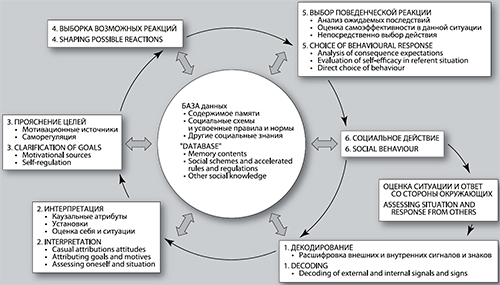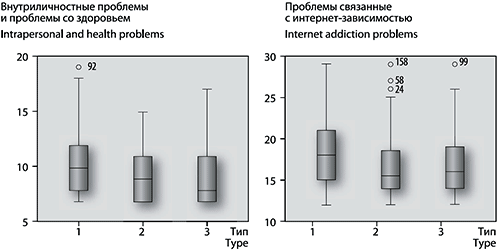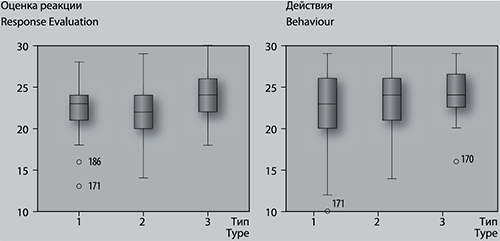Role of personality features of adolescents in processing information via social network communication
Recieved: 11/24/2018
Accepted: 12/07/2018
Published: 12/30/2018
Pages: 3-15
DOI: 10.11621/npj.2018.0401
Keywords: basic assumptions; moral values; cognitive methods of social information processing; adolescence; Internet dependence
Available online: 30.12.2018
Molchanov, S.V. , Almazova, O.V., Voiskounsky Alexandr E., Poskrebysheva, N.N. (2018). Role of personality features of adolescents in processing information via social network communication. National Psychological Journal, (4) , 3-15. https://doi.org/10.11621/npj.2018.0401
Copied to Clipboard
CopyAbstract
Introduction Informational socializing of modern adolescents influences the form of communication as the main source of development and self-determination as the major developmental factor in adolescence. The investigation of links between personal features and moral values and Internet involvement allows defining the problem of correlations between personal and cognitive component of development and prevent cyberbulling and communication on-line risks.
The Objective of the study is to investigate the correlation between basic attitude and moral values of adolescents and the productivity of cognitive processing of social information on the Internet. The hypothesis of the study is the assumption that adolescents with a positive attitude to the mediated world and a high level of moral values reveal greater productivity of cognitive methods of processing social information obtained on the Internet. One of the goals of the research was to identify the relationship between basic beliefs and the Internet addiction in adolescents.
Methods and sampling. The study used the following methods: 1. Basic Belief Scale by R. Yanoff-Bulman (Kalmykova, Padun, 2002); 2. Methods of diagnosing moral values "Fair-Care" (S. Molchanov, A. Podolsky); 3) the author's method of cognitive assessment of social information on the Internet, based on the Crick and Dodge model (Crick, Dodge, 1994); 4. Method of diagnosing Internet-dependent behavior by S.H.Chen. The population aged 13 to 18 years accounted 175 adolescents (49% males and (51% females).
Results. Three groups of adolescents were different in the nature of basic assumptions and the level of development of moral values optimists, pessimists, and ego-centered pessimists, and Internet addicted. Comparative analysis of the cognitive methods of processing social information on the Internet, as well as signs of Internet addiction was carried out.
Conclusions: The hypothesis that positive attitude to the mediated world and belief that they control life, a high level of moral values associated with more productive cognitive methods of processing social information on the Internet has received confirmation. A group of adolescents identified as “pessimists” (perception of the world as hostile, negative image of themselves, lack of confidence in the world and success, low level of moral values) reveal signs of Internet addiction in behaviour.

Fig. 1. Map of cognitive processing of social information

Fig. 2. Assessment of “intrapersonal problems and health problems” and “problems associated with Internet addiction” symptoms with different types of perceptions and moral organization of the mediated world

Fig. 3. Diagrams of assessment scope of “Response Evaluation” and “Behaviour” with different types of perception and moral organization of the surrounding world
Table 1. Major psychometric assessments on the Basic Belief Scale questionnaire (BBS) in females and males, and differences
|
Scale |
Whole Sample |
Males |
Females |
Differences |
||||
|
Me |
SD |
Me |
SD |
Me |
SD |
t |
p |
|
|
BBS 1 |
6,51 |
2,65 |
6,48 |
2,77 |
6,53 |
2,54 |
-0,142 |
0,887 |
|
BBS 2 |
4,40 |
2,77 |
4,34 |
2,64 |
4,47 |
2,90 |
-0,306 |
0,760 |
|
BBS 3 |
6,41 |
3,18 |
6,49 |
3,04 |
6,33 |
3,32 |
0,329 |
0,743 |
|
BBS 4 |
7,96 |
2,57 |
7,72 |
2,77 |
8,16 |
2,35 |
-1,125 |
0,262 |
|
BBS 5 |
6,71 |
2,47 |
6,95 |
2,45 |
6,47 |
2,48 |
1,304 |
0,194 |
BBS 1 –Benevolence of the mediated world, BBS 2 – fairness of mediated world, BBS 3 – Positive I-image, BBS 4 – faith in luck, BBS 5 – belief in control over life.
Table 2. Major psychometric assessments on Fair-Care Scale in females and males, and differences
|
Scale |
Whole Sample |
Males |
Females |
Differences |
||||
|
Me |
SD |
Me |
SD |
Me |
SD |
t |
p |
|
|
FPA |
2,21 |
0,75 |
2,28 |
0,80 |
2,20 |
0,71 |
0,261 |
0,794 |
|
FPI |
2,40 |
0,79 |
2,36 |
0,84 |
2,45 |
0,74 |
-0,713 |
0,477 |
|
FСF |
2,77 |
0,78 |
2,70 |
0,80 |
2,86 |
0,75 |
-1,170 |
0,244 |
|
FСS |
2,68 |
0,77 |
2,66 |
0,72 |
2,70 |
0,82 |
-0,349 |
0,727 |
|
FPS |
3,74 |
0,86 |
3,56 |
0,83 |
3,92 |
0,85 |
-2,885 |
0,004 |
|
FPU |
3,46 |
0,79 |
3,49 |
0,78 |
3,43 |
0,80 |
0,454 |
0,650 |
|
CS-cP |
2,82 |
0,80 |
2,86 |
0,82 |
2,78 |
0,79 |
0,699 |
0,486 |
|
CS-cO |
3,34 |
0,82 |
3,22 |
0,87 |
3,46 |
0,76 |
-2,003 |
0,047 |
|
CS-sR |
3,44 |
0,75 |
3,42 |
0,73 |
3,46 |
0,77 |
0,400 |
0,690 |
|
CS-sC |
3,19 |
0,84 |
3,08 |
0,87 |
3,29 |
0,81 |
-1,664 |
0,098 |
|
CS-rP |
3,10 |
0,58 |
3,01 |
0,58 |
3,19 |
0,56 |
-2,007 |
0,046 |
Fairness. 1. Preconventional level: FPA – power of authorities, fear of punishment; FPI – instrumental exchange «you – to me, I – to you». 2. Convention: FСF – focus on the opinions of others, the desire “to be good»; FСS – Social law and order. 3. Postconventional level: FPS – social contact, importance of individual rights; FPU – stage of universal ethical principles. Care. 1. Self-concern; CS-cP – focus on the self and personal interests; CS-cO – focus on the opinions of others and good opinion of the self. 2. Self-sacrifice: CS-sR – reflexive empathic orientation; CS-sC – concern of internalized values, protecting the rights of others. 3. Self-respect: CS-rP – perceived concern of internalized values.
Table 3. Cluster centers of respondents according to the perception of the world and perceiving the self in this world
|
|
Name |
Type 1 |
Type 2 |
Type 3 |
|
Benevolence of the mediated world |
BBS 1 |
5 |
5 |
9 |
|
Fairness of the mediated world |
BBS 2 |
3 |
3 |
7 |
|
Positive I-image |
BBS 3 |
3 |
8 |
8 |
|
Faith in luck |
BBS 4 |
6 |
9 |
9 |
|
Belief in control over life |
BBS 5 |
5 |
7 |
8 |
|
Power of authorities, fear of punishment |
FPA |
2,3 |
2,2 |
2,1 |
|
Instrumental exchange |
FPI |
2,5 |
2,4 |
2,3 |
|
Focus on the opinions of others |
FСF |
2,7 |
2,8 |
2,8 |
|
Social law and order |
FСS |
2,5 |
2,8 |
2,7 |
|
Social contact, importance of individual rights |
FPS |
3,7 |
3,8 |
3,8 |
|
Stage of universal ethical principles |
FPU |
3,3 |
3,5 |
3,6 |
|
Focus on the self and personal interests |
CS-cP |
2,9 |
2,9 |
2,7 |
|
Focus on the opinions of others |
CS-cO |
3,3 |
3,3 |
3,4 |
|
Reflexive empathic orientation |
CS-sR |
3,2 |
3,4 |
3,6 |
|
Concern of internalized values |
CS-sC |
3,1 |
3,0 |
3,4 |
|
Perceived concern of internalized values |
CS-rP |
3,0 |
3,0 |
3,3 |
|
Respondents |
|
58 |
57 |
60 |
Table 4. Females and males by type of world view and basic moral regulation
|
|
Type 1 |
Type 2 |
Type 3 |
|
Males |
32,6% |
32,6% |
34,8% |
|
Females |
33,7% |
32,6% |
33,7% |
Table 5. Average scores of different aspects of Internet addiction in adolescents with different types of perception and moral regulation in the mediated world, and differences
|
|
Type 1 |
Type 2 |
Type 3 |
Differences |
|
|
K-W |
p |
||||
|
Compulsive Symptoms |
9,11 |
8,19 |
8,47 |
2,601 |
0,272 |
|
Withdrawal Symptoms |
9,98 |
9,35 |
9,13 |
1,924 |
0,382 |
|
Symptoms of Tolerance |
7,09 |
6,30 |
6,98 |
4,525 |
0,104 |
|
Intrapersonal and health problems |
11,12 |
9,72 |
9,36 |
5,746 |
0,057 |
|
Time Management problems |
8,51 |
7,56 |
7,97 |
3,119 |
0,210 |
|
Main Symptoms of Internet Adddiction |
26,18 |
23,84 |
24,58 |
2,034 |
0,362 |
|
Internet addiction problems |
19,63 |
17,28 |
17,78 |
5,298 |
0,071 |
|
Total Score of Internet Addiction |
45,81 |
41,12 |
42,37 |
3,723 |
0,155 |
Table 6. Average scores of cognitive assessment in adolescents with different types of perception and moral regulation in the mediated world, and differences
|
|
Type 1 |
Type 2 |
Type 3 |
Differences |
|
|
K-W |
P |
||||
|
Perception |
22,71 |
22,23 |
22,20 |
0,733 |
0,693 |
|
Interpretation |
22,03 |
22,07 |
22,00 |
0,041 |
0,980 |
|
Response |
21,47 |
22,46 |
22,77 |
4,416 |
0,110 |
|
Response Evaluation |
22,52 |
22,37 |
23,63 |
6,941 |
0,031 |
|
Behaviour |
22,52 |
23,30 |
24,27 |
5,198 |
0,074 |
References:
Bochaver A.A., & Khlomov K.D. (2014). Cyberbullying: Harassment in Modern Technologies. Psychology. [Zhurnal vysshey shkoly ekonomiki], 11(3), 177–191.
Crick N.R., & Dodge K.A. (1994). A review and reformulation of social information-processing mechanisms in children’s social adjustment. Psychological Bulletin, 115, 74–101. doi: 10.1037/0033-2909.115.1.74
Dodge K.A., Malone P.S., Lansford J.E., Sorbring E., Skinner A.T., Tapanya S., Uribe Tirado L.M., Zelli A., Alampay L.P., Al-Hassan S.M., Bacchini D., Bombi A.S., Bornstein M.H., Chang L., Deater-Deckard K., Di Giunta L., Oburu P., & Pastorelli C. (2015). Hostile attributional bias and aggressive behavior in global context. Proceedings of the National Academy of Sciences, 112, 9310–9315. doi:10.1073/pnas.1418572112.
Erdley C.A., Rivera, M.S., Shepherd E.J., i Holleb L.J. (2010). Social-Cognitive Models and Skills. In: D. W. Nangle, D. J. Hansen, C. A. Erdley i P. J. Norton (ur.), Practitioner’s Guide to Empirically Based Measures of Social Skills, 21–35. New York: Springer. doi: 10.1007/978-1-4419-0609-0_2
Granovetter M. (2009). The strength of weak ties. [Ekonomicheskya sotsiologiya], 10(4), 31–50.
Janoff-Bulman R. (1985). The aftermath of victimisation: Rebuilding shattered assumption. In C.R.Figley (Ed.) Trauma and its wake. N.Y., Brunner/ Mazel, 15–35.
Kalmykova E.S., & Padun M.A. (2002). Early attachment and its impact on resistance to mental trauma. [Psikhologicheskiy zhurnal], 5(23), 51–59.
Kulikova T.I., & Maliy D.V. (2015). The correlation between a passion for computer.
Laghi F., Schneider B.H., Vitoroulis I. at al. (2013). Knowing when not to use the Internet: Shyness and adolescents’ on-line and off-line interactions with friends. Computers in Human Behavior, 29, 51–57. doi: 10.1016/j.chb.2012.07.015
Lemerise E. A., & Arsenio W. F. (2000). An integrated model of emotion processes and cognition in social information processing. Child Development, 71, 107–118. doi: 10.1111/1467-8624.00124
Livingstone S., Haddon L., Görzig A. and Ólafsson K. (2011). Risks and safety on the internet: The perspective of European children: Full findings. Retrieved from http://eprints.lse.ac.uk/33731/ (appeal date: 12.15.2018).
Martsinkovskaya T.D. (2012). Information socialization in a changing information space. [Psikhologicheskie issledovaniya],5(26), 7. Retrieved from: http://psystudy.ru/num/2012v5n26/766-martsinkovskaya26.html. (appeal date: 12.15.2018).
Molchanov S.V. (2011). Morality of justice and morality of care: foreign and domestic approaches to moral development. [Vestnik Moskovskogo universiteta], Series 14. Psychology, 14(2), 59–72.
Molchanov S.V. (2016). Psychology of adolescence and adolescence. Moscow, Yurayt.
Molchanov S.V. (2017). Personal factors of acceptance of moral responsibility in adolescence. National Psychological Journal, 4, 114–120. doi: 10.11621/ npj.2017.0411
Molchanov S.V., Almazova O.V., Poskrebysheva N.N., & Zapunidi A.A. (2017). Personal autonomy as a factor in the development of adolescent responsibility. National Psychological Journal,1, 84–90. doi: 10.11621/npj.2017.0110
Rasskazova E.I., Emelin V.A., & Tkhostov A.Sh. (2015). Diagnosis of the psychological consequences of the influence of information technology on a person. Moscow, Akropolis.
Roulann E.G. (2012). How to stop bullying at school. Mobbing psychology. Moscow, Genesis.
Sebastian Ludwig Hirn, Joachim Thomas, & Christof Zoelch (2018). The role of empathy in the development of social competence: a study of German school leavers. International Journal of Adolescence and Youth. 1–13. doi: 10.1080/02673843.2018.1548361.
Soldatova G.U. (2018). Digital socialization in the cultural-historical paradigm: a changing child in a changing world. [Sotsial’naya psikhologiya i obshchestvo], 9(3), 71–80.
Soldatova G.U., & Rasskazova E.I. (2017). «The downside» of digital competence of Russian adolescents: the illusion of competence and risky behavior online. [Voprosy psikhologii], 3, 3–15.
Spitzer M. (2014). Antimazg: digital technology and the brain. Moscow, AST.
Trekels, J., Ward, L.M., Eggermont, S. (2018). I “like” the way you look: How appearance-focused and overall Facebook use contribute to adolescents’ self-sexualization. Computers in Human Behavior, 81, 198–208. doi: doi: 10.1016/j.chb.2017.12.020
Turkle, Sh. (1996). Parallel lives: Working on identity in virtual space. Constructing the self in a mediated world. Inquiries in social construction. Grodin D., Lindlof T.R. (Eds.). Sage Publications, Inc, Thousand Oaks, CA, US, 156–175. 10.4135/9781483327488.n10
Voiskounsky, A.E. (2010). Internet Addiction in the Context of Positive Psychology. Psychology in Russia: State of the Art, 3, 541–549. doi: 10.11621/ pir.2010.0026
Voiskunsky, A.E. (2017). Directions of research mediated by the Internet activities. [Vestnik Moskovskogo universiteta]. Series 14. Psychology, 1, 51–66.
Voyskunsky A.E. (2014). Social perception in social networks. [Vestnik Moskovskogo universiteta]. Series 14. Psychology, 2, 90–104.
Voyskunsky A.E. (2017). Distribution of assistance in the information society. [Gosudarstvo i grazhdane v elektronnoy srede]. Issue 1. St. Petersburg, Universitet ITMO, 308–314.
Voyskunsky A.E. (Ed.) (2009). Internet addiction: psychological dependence and dynamics of development. Moscow, Ackropolis.
Wilson, B.J. (1985). Developmental differences in empathy with a television protagonist’s fear. Journal of Experimental Child Psychology, 39, 284–299. doi: 10.1016/0022-0965(85)90042-6
Young, K.S. (1998). Internet addiction: The emergence of a new clinical disorder. CyberPsychology and Behavior, 3(1), 237–244. doi: 10.1089/ cpb.1998.1.237Molchanov, S.V. , Almazova, O.V., Voiskounsky Alexandr E., Poskrebysheva, N.N. . Role of personality features of adolescents in processing information via social network communication. // National Psychological Journal 2018. 4. Pages3-15. doi: 10.11621/npj.2018.0401
Copied to Clipboard
Copy

